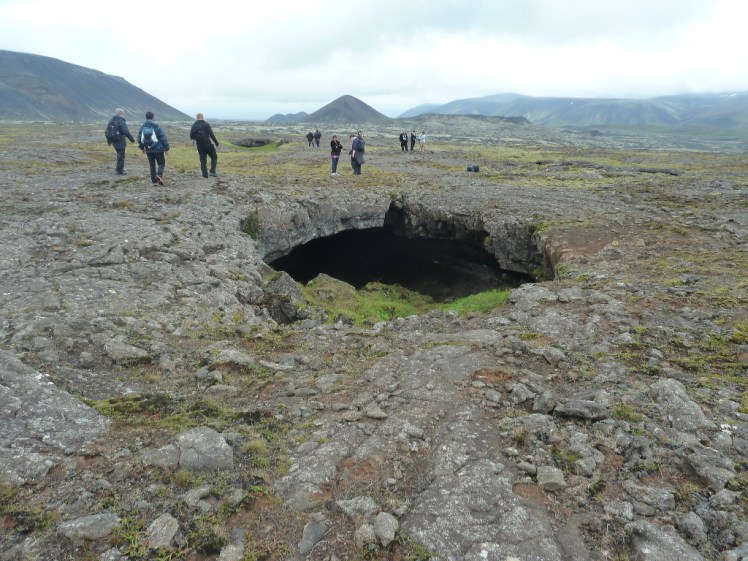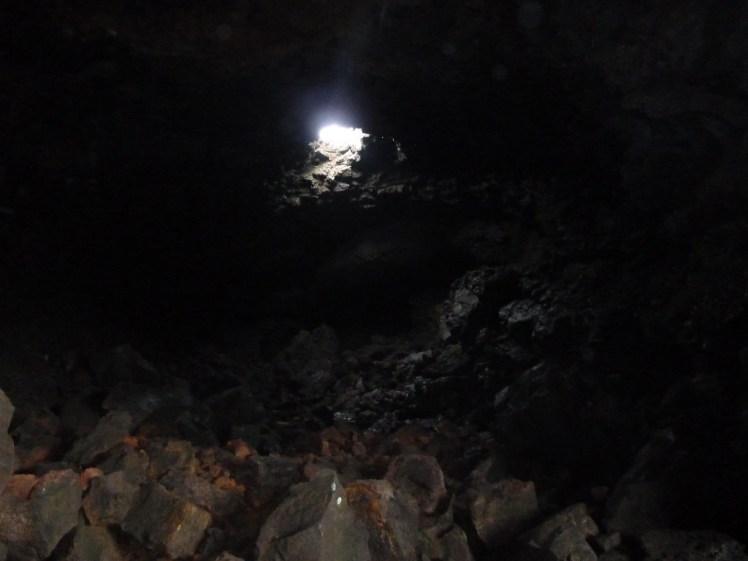I can’t believe we’re so close to the end of the A-Z of Iceland. We’re at U already and today we’re going for one of my favourite subjects: the underground.
In its way, there isn’t a lot underneath Iceland. It was formed less than sixteen million years ago when two tectonic plates tore apart and the magma that poured through formed a new island. It’s just a baby layer of rock where the North Atlantic Rift comes up and breaks through the waves.
But there is stuff going on beneath the surface. Sometimes when lava flows, the top layer cools, leaving a river of the molten stuff running beneath. Sometimes that lower layer cools too and then you get solid lava. Sometimes the liquid continues running away, leaving an empty tube just beneath the surface. Sometimes these collapse on themselves – the top is fairly thin and fragile and it falls into the tube, leaving a roundish valley. None of it was caused by water action. Lava’s very porous and although it rains plenty in Iceland, the water filters straight through the rock. Rivers don’t really form on lava fields and water action doesn’t cause erosion.

If you haven’t gathered from previous blogs, I was a caver in another life. I’m very accustomed to limestone caves. I know about calcium carbonate and karst and phreatic vs vadose action. I know the smell of wet limestone and the fossils and quartz and little bits of sparkle that get trapped in the rock.
It’s therefore utterly alien to me to explore caves where this isn’t happening. I see stalactites but they’re not formed by calcium suspended in water droplets, it’s just where the lava dripped as it dried. So familiar yet so different. I’ve only ever been lava caving in winter so long perfect icicles form, and sometimes I crash into them and smash them which is an act of stupid clumsiness in a lava cave but an act of unforgivable vandalism in a limestone cave, where the temperature is consistent year-round and icicles don’t form.

The thing is, a lot of Iceland is made of lava. No one really knows where all the lava caves are. That’s partly because there’s a lot of desolate area where they can be hiding and partly because they don’t all have an easily-explorable opening. And it’s not a wise idea to go exploring one you’ve randomly found. Those little pockets in the ground could easily contain a build-up of volcanic gases formed when the lava was fresh an liquid. Nothing like a layer of solid rock to hold a few lungsful of something nasty for a few thousand years.
But there are a few that are open and safe and there are tour guides who will take you into them. I’ve been down into Leiðarendi, half an hour or so outside Reykjavik. Leiðarendi means “journey’s end”, so-called because the bones of a dead sheep were found in the furthest reaches of it. Good luck finding it on your own; it’s a small hole in the middle of a lava field.


And then there’s another underground. I’ve written about that too. Þríhnúkagígur, Three Peaks Crater, is that unusual thing – a volcano with an empty magma chamber. No one knows where exactly the magma went. Probably just drained back into the mantle. Anyway, it leaves a big hollow volcano. It’s not that big from the outside but inside, you could drop the Statue of Liberty and she wouldn’t even touch the sides. I still grumble about it occasionally because it was only supposed to be open for six weeks in the summer of 2012 and I thought I was having a once-in-a-lifetime opportunity to go inside a volcano but it’s still open today and it’s all year round.

As Iceland underground goes, it’s pretty amazing. It’s a huge tear-shaped chamber, its walls streaked with sulphur and iron, all scorched and rainbow-coloured and I can see that it goes deeper: I tried it. I didn’t try seriously because I was a caver long enough to know that might not be the brightest idea ever and also I was with a tour group that was going to get angry if I disappeared below the bowels of the Earth.


But on the way back we came across the collapsed remains of two lava tubes and because we had time and because my guides were angels and because I mentioned that I was interested, they let us go exploring in there for a few minutes on our way to the minibus and for that I’m eternally grateful. These ones were the kind that are little more than a scoop out of the lava field, with very little roof left but it was wonderful to be allowed to scramble around in them.


The one underground that I haven’t explored yet is the ice caving. I’m reluctant to call it “underground” because it happens up on the glaciers, which are very much above ground and going inside the snow and ice is not the same thing as going beneath the ground. Even more than lava caving, this is something to not try on your own. You don’t know anything about glaciers. You certainly don’t know when they’re going to collapse and bury you under thousands or millions of tons of very solid ice. If you want to try some long-way-above-the-ground underground exploration, please do get a professional guide. Other than that warning, I’ll leave this one alone since I don’t know much about it.
And that’s it for my quick run through Iceland underground. Next time we come to my actual favourite Iceland subject: the Volsung Saga. I’ve been looking forward to this one all year.